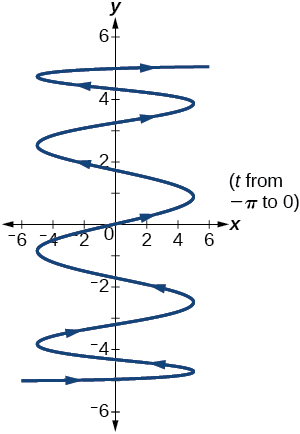| << Chapter < Page | Chapter >> Page > |
Graph on the domain where and , and include the orientation.

If is 1 more than describe the effect the values of and have on the graph of the parametric equations.
Describe the graph if and
There will be 100 back-and-forth motions.
What happens if is 1 more than Describe the graph.
If the parametric equations and have the graph of a horizontal parabola opening to the right, what would change the direction of the curve?
Take the opposite of the equation.
For the following exercises, describe the graph of the set of parametric equations.
and is linear
and is linear
Write the parametric equations of a circle with center radius 5, and a counterclockwise orientation.
Write the parametric equations of an ellipse with center major axis of length 10, minor axis of length 6, and a counterclockwise orientation.
For the following exercises, use a graphing utility to graph on the window by on the domain for the following values of and , and include the orientation.
For the following exercises, look at the graphs that were created by parametric equations of the form Use the parametric mode on the graphing calculator to find the values of and to achieve each graph.
For the following exercises, use a graphing utility to graph the given parametric equations.
Graph all three sets of parametric equations on the domain
The graph of each set of parametric equations appears to “creep” along one of the axes. What controls which axis the graph creeps along?
Explain the effect on the graph of the parametric equation when we switched and .
The -intercept changes.
Explain the effect on the graph of the parametric equation when we changed the domain.
An object is thrown in the air with vertical velocity of 20 ft/s and horizontal velocity of 15 ft/s. The object’s height can be described by the equation , while the object moves horizontally with constant velocity 15 ft/s. Write parametric equations for the object’s position, and then eliminate time to write height as a function of horizontal position.
A skateboarder riding on a level surface at a constant speed of 9 ft/s throws a ball in the air, the height of which can be described by the equation Write parametric equations for the ball’s position, and then eliminate time to write height as a function of horizontal position.
For the following exercises, use this scenario: A dart is thrown upward with an initial velocity of 65 ft/s at an angle of elevation of 52°. Consider the position of the dart at any time Neglect air resistance.
Find all possible values of that represent the situation.
When will the dart hit the ground?
approximately 3.2 seconds
Find the maximum height of the dart.
At what time will the dart reach maximum height?
1.6 seconds
For the following exercises, look at the graphs of each of the four parametric equations. Although they look unusual and beautiful, they are so common that they have names, as indicated in each exercise. Use a graphing utility to graph each on the indicated domain.
An epicycloid: on the domain .
A hypotrochoid: on the domain .

Notification Switch
Would you like to follow the 'Precalculus' conversation and receive update notifications?